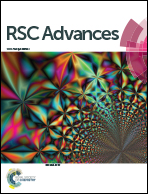A nanoporous carbon material derived from pomelo peels as a fiber coating for solid-phase microextraction†
Abstract
In this work, we present a facile and economical approach to synthesize a nanoporous carbon via a KOH chemical activation process using waste pomelo peels as the biomass precursor. The nanoporous carbon derived from pomelo peels exhibits a nanoporous structure (pore size, 0.69 nm) and high surface area (1770 m2 g−1). To evaluate the extraction performance of the nanoporous carbon, it was applied as a solid-phase microextraction coating for the enrichment of benzene homologues from water and soil samples prior to their determination by gas chromatography-mass spectrometry. The main influencing experimental parameters for the extraction were investigated and optimized. Under the optimum conditions, a good linearity for the signal response was achieved in the concentration range of 0.4–100.0 ng L−1 for water samples and 5.0–1000.0 ng kg−1 for soil samples with determination coefficients (r2) larger than 0.9960. The limits of detection (S/N = 3) of the method ranged from 0.05 to 0.18 ng L−1 for water samples and from 0.11 to 0.18 ng kg−1 for soil samples, respectively. The recoveries of the analytes were in the range of 81.3–112.0% with the relative standard deviations (RSDs) ranging from 1.5% to 11.4% (n = 5). The single fiber repeatability and fiber-to-fiber reproducibility values expressed as RSDs were in the range of 2.4–8.1% and 5.9–9.9%, respectively. The method was simple, convenient and feasible for the determination of benzene homologues in real samples.


 Please wait while we load your content...
Please wait while we load your content...